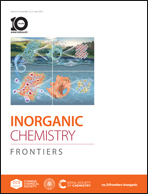A honeycomb carbon substrate anchored with Sn and Sb bimetallic atoms boosts oxygen-reduction electrocatalysis†
Abstract
The slow oxygen-reduction reaction (ORR) kinetics is due to the high reaction barrier during the multiple electron transfer process, therefore, finding efficient catalysts to reduce the reaction barrier is of great significance. Currently, the most efficient ORR electrocatalysts are based on platinum-based materials, but their commercial application is limited by their high cost and low stability. To solve this problem, in this paper, a honeycomb carbon substrate with a porous structure and large specific surface area was formed by etching SiO2 templates, and subsequently, an SnSb-NC catalyst was prepared by anchoring Sn and Sb onto the honeycomb carbon substrate. In alkaline media, SnSb-NC has outstanding ORR activity with a greater half-wave potential (E1/2) of 0.87 V than Pt/C (0.83 V) and excellent electrochemical stability. The excellent ORR electrocatalyst performance may be attributed to the porous honeycomb structure with a high specific surface area (1717.4 m2 g−1), which facilitates mass/electron transfer and exposure of more active sites, as well as the synergistic effect generated by the atomically dispersed Sn and Sb metal sites in the honeycomb carbon substrate. On this basis, the assembled Zn–air battery has a great power density (195.8 mW cm−2), while the battery can run stably for more than 1100 hours, and is more stable than most of the Zn–air batteries reported so far.

- This article is part of the themed collection: 2023 Inorganic Chemistry Frontiers HOT articles


 Please wait while we load your content...
Please wait while we load your content...